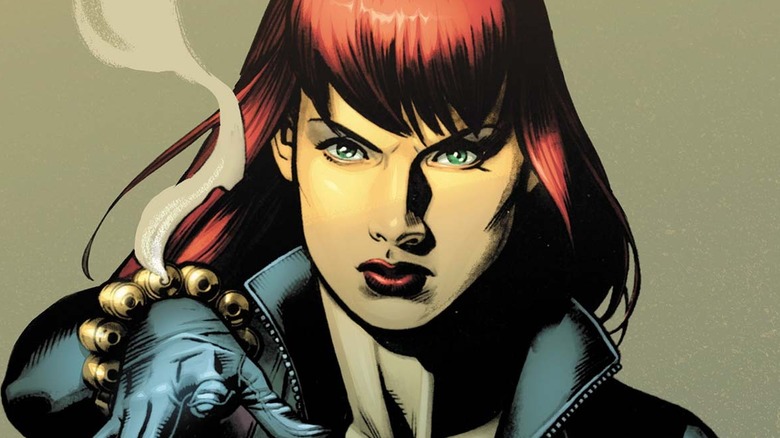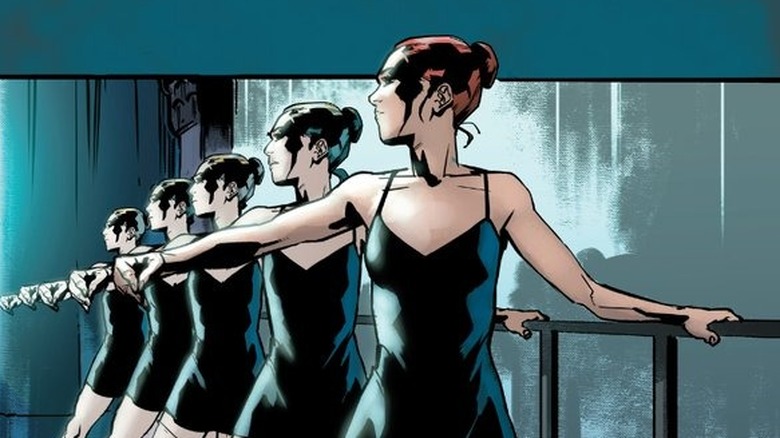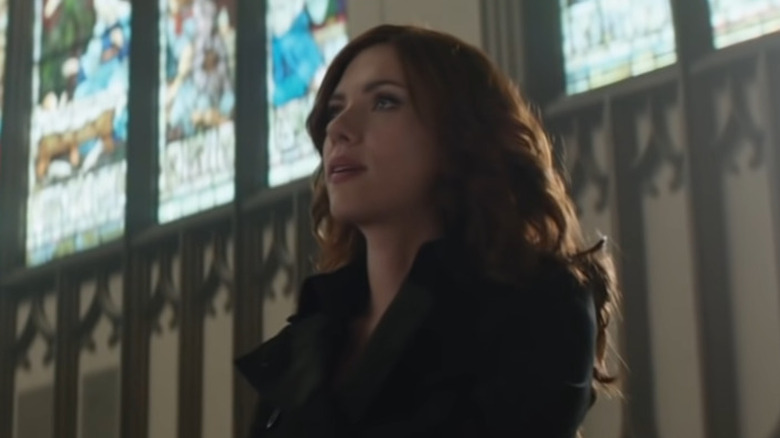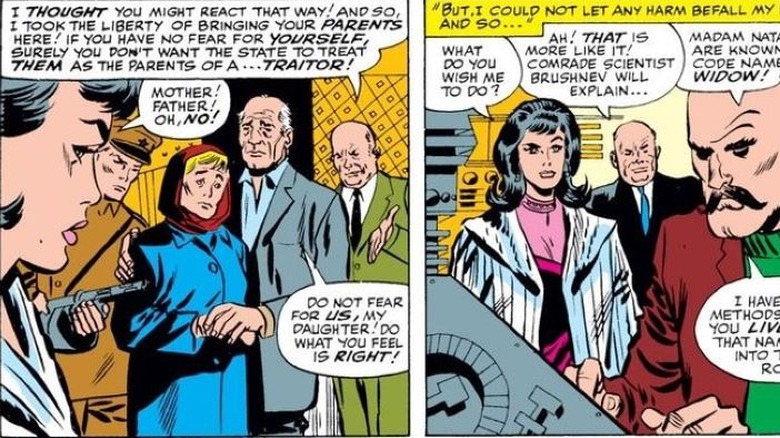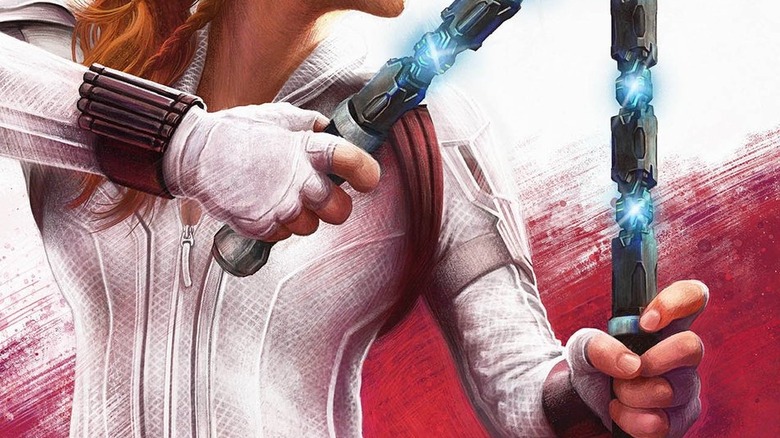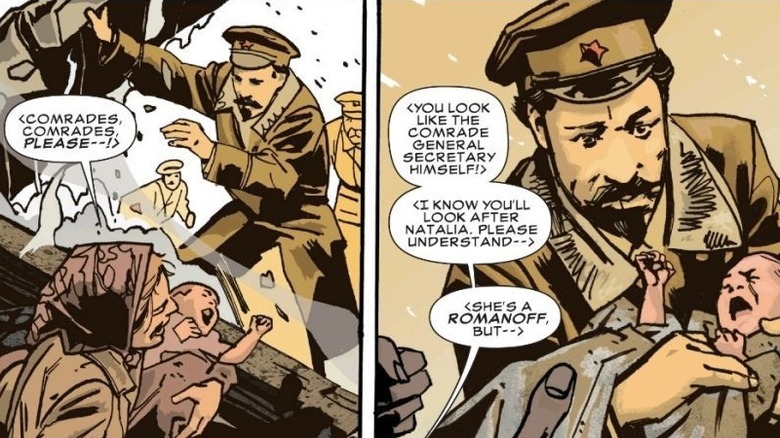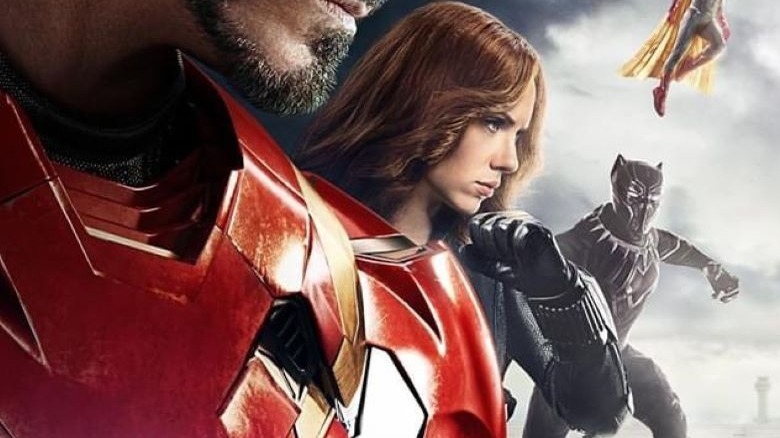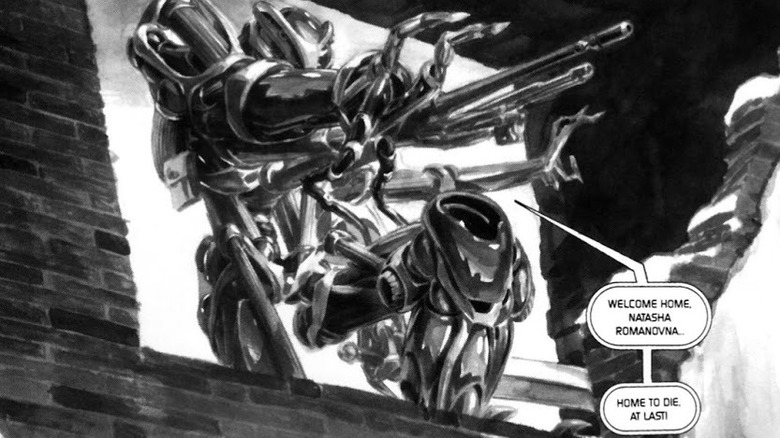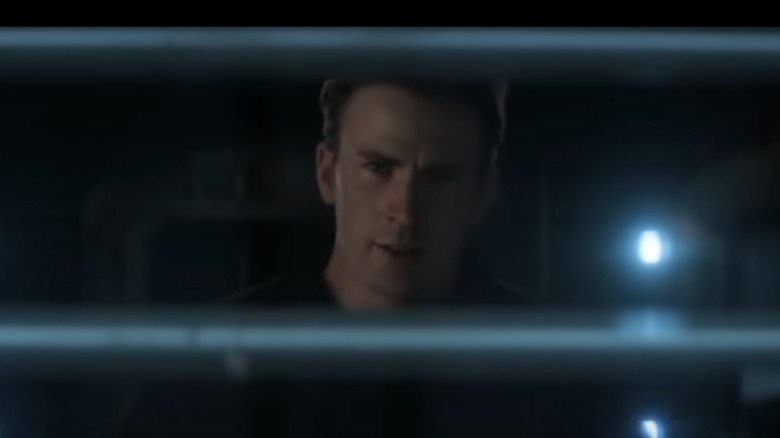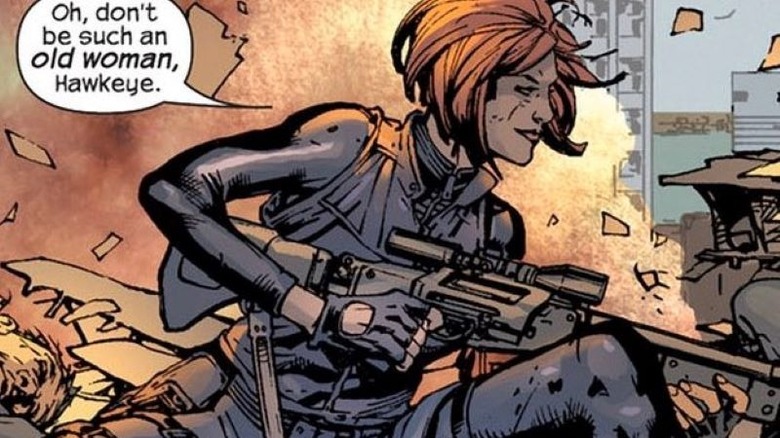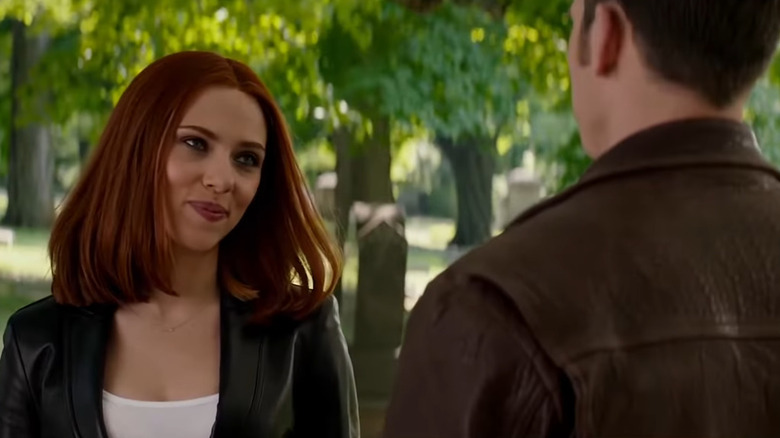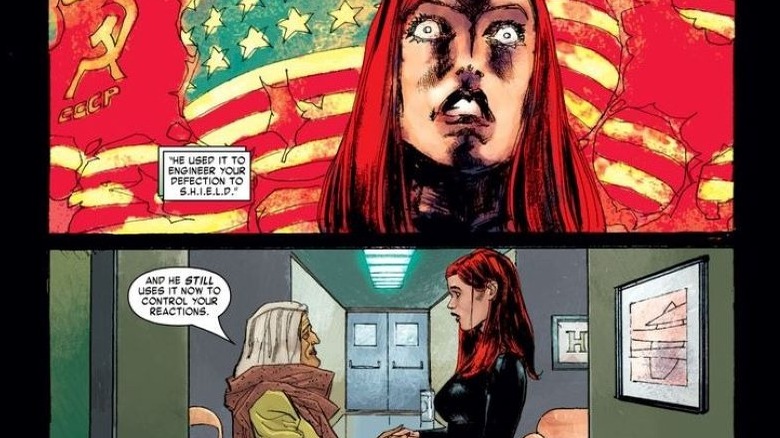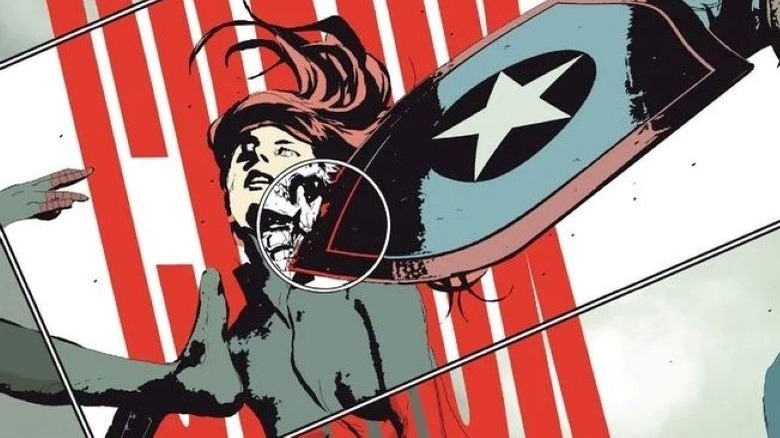Ways Marvel Lied To You About Black Widow
Lies and misdirection are standard tools in every good spy's toolbox, and the Black Widow is certainly no exception. Since her first appearance in 1964's "Tales of Suspense" #52, Natasha Romanoff has been completing missions and neutralizing her targets through good old tricks and deception — even before she started showcasing the hand-to-hand combat expertise, weapons mastery, and high-tech equipment that define modern takes on the character. Unbeknownst to many fans, the stories they were told while following the stealthy Avenger's adventures in both comics and film turned out to be less-than-truthful on numerous occasions.
That's not to say, however, that Marvel actually set out to lie to its loyal fans about the Black Widow. Many of the falsehoods surrounding the heroine's identity across various media platforms was less about the company being dishonest and more about the visions of the character's different writers over the years not lining up perfectly. Besides, it's not easy reconciling decades of comic book continuity, especially for a character with such a long and inconsistent background story. Nevertheless, here are some of the instances when Marvel ended up bamboozling fans about the Black Widow. Oh, and there will be spoilers about the 2021 film "Black Widow."
Black Widow's career as a ballerina was a fake memory
Given her incredible dexterity and grace in combat, it's not a stretch to believe that the Black Widow would have made a terrific ballerina. In fact, Natasha talked about this aspect of her past quite frequently, particularly when she was sharing a book with the blind lawyer-slash-superhero, Daredevil. Her origin story at the time established that she was originally a ballerina at the Russian Bolshoi theater, but decided to work for the Soviet government as their secret operative to honor the death of her husband, a test pilot named Alexei.
In subsequent stories, however, numerous contradictory accounts of Natasha's life while growing up came to light. It soon became apparent that her history was actually shrouded in mystery; in fact, many of the things that Natasha herself believed were true turned out to be the opposite. It all came to a head in her eponymous 2004 miniseries, where it was explained that her memories of her ballet career were fabricated, implanted in her brain by her supervisors at the Red Room to better control her. Aside from altering her mind, they also subjected Natasha to a series of experiments that greatly slowed her aging process and kept her in peak human condition throughout the decades, while leaving a nasty failsafe inside her: Whenever she'd try to make sense of her conflicting memories, she would quickly feel the need to puke.
Natasha lied to Steve about knowing her parents
There's a touching exchange between Natasha and Steve Rogers (Captain America) that didn't make it to the final cut of 2016's "Captain America: Civil War." In the extended scene, Natasha walks up to Steve right after the funeral of his World War II sweetheart, Peggy Carter. In an attempt to comfort Steve and help him realize the importance of valuing the things he still had in his life, Natasha shared that she found and visited her parents' graves after the events of the previous film. This conversation established that at that point, Natasha already had an idea of who her parents were.
That is, until "Black Widow" revealed that Natasha never even got to know or meet her parents. Her mother had sold her to the Red Room right after she was born, but seemingly regretted it almost immediately. Tragically, General Dreykov had her killed to keep the existence of the Red Room a secret, and allegedly had her buried under "a tree with pink flowers" with a bare headstone. This was new knowledge to Natasha — and since "Black Widow" takes place after "Civil War," she couldn't have visited her parents' graves like she told Steve.
Interestingly, this lines up with Natasha and Clint's quest to obtain an Infinity Stone in "Avengers: Endgame." After the Red Skull called her the "daughter of Ivan," she immediately tells the archer that this was the first time she found out what her father's name was.
Natasha's "parents" were just fakes brought in to manipulate her
Black Widow's backstory hadn't been well-established in her earliest appearances, making it easy for just about any writer to jump in and add to her mythos without having to read other writers' work on the character. That's why twelve issues after her debut, Marvel was able to show a more sympathetic side of Natasha, while explaining why she was so determined to carry out her missions as a Soviet spy. "Tales of Suspense" #64 revealed that Natasha was following orders from the Soviet government because her parents were being threatened by her superiors. Oddly enough, for a pair of characters who were so important to Natasha, this was their first and only appearance.
However, as Marvel's roster of books and writers continued to increase, keeping consistency and continuity across different writers' stories quickly became a herculean task. Small but crucial details of some characters' histories would fall through the cracks; meanwhile, other protagonists' origin stories had the opportunity to be more fully fleshed out.
In the case of Natasha, it was both: A 1972 issue of "Daredevil" revealed that Natasha was actually an orphan trained as an assassin at a young age, who never even got to know her mother and father. This version of Natasha's personal history was further solidified by the 2009 "Black Widow: Deadly Origin" limited series: As it turns out, her memories of her parents turned out to be mere memory implants as well.
Black Widow's weapons weren't actually S.H.I.E.L.D.-issued
From the shocking Widow's Bite stingers around her wrist to the electronic face masks she uses to convincingly switch identities, Black Widow has a veritable arsenal of high-tech gadgets at her disposal that can make any super-spy green with envy. Ever since her debut in the Marvel Cinematic Universe, her state-of-the-art weapons have been as much a part of her character as her intense combat skills. Naturally, the reasonable conclusion was that S.H.I.E.L.D. (and later, Tony Stark) was providing her with all of the tech she needed to carry out her missions as both a secret agent and an Avenger.
Thus, it comes as a bit of a shock to find out that Natasha had actually been using all that gear even before she defected to Nick Fury's side. Her solo film revealed that Melina Vostokoff, her fellow agent and former guardian back when she was a Russian spy, was actually the brains behind her signature weapons. Vostokoff's farmhouse even had a secret room, with walls full of different guns, stun batons, disguises, and more. Perhaps S.H.I.E.L.D. realized that Natasha's Red Room weapons offered too much of a tactical advantage to waste.
Marvel couldn't stick to a single origin for Natasha
In the comics, Natasha's character history is long, confusing, and at times conflicting. One of the most persistent versions of her origin was that she was an orphan rescued from either a burning building in 1942 or collapsed rubble in 1928. In both of these retellings, baby Natasha's savior was a chauffeur named Ivan Petrovich, who ended up raising her until she was old enough to become a spy for the Soviets.
Years later, "Uncanny X-Men" #128 threw a wrench in the equation with a new revelation that didn't jive with either story: In 1941, right in the middle of the second World War, Natasha was saved from the Nazis by none other than Captain America and Logan (the mutant known as Wolverine). In yet another X-Men-related comic, Logan reminisced about the brief time he met and trained the future Black Widow when she was still an adolescent girl. Marvel's later attempts to reconcile all of these contradictory accounts of Natasha's history led to many of them being identified as possibly planted memories. Others were simply flat-out ignored in subsequent stories.
As for Ivan, Natasha ended up facing off against him many years later, when he resurfaced as an unhinged cyborg who threatened to nuke the planet. The Black Widow had no choice but to end his life (which, in many ways, was a mercy killing).
Marvel dropped zero hints of Black Widow's "Civil War" betrayal
To keep many of the crucial plot points and revelations of 2016's "Captain America: Civil War" a secret, Marvel Studios was especially careful about its promotional materials. Most notably, they kept Spider-Man (a character who had yet to appear in any of the MCU films at the time) out of posters and stills during a significant part of the campaign. However, a few other key details were understandably left out or cast in a completely different light — including Black Widow's choices and true allegiance in the battle between Captain America and Iron Man.
With the Avengers fractured by the Sokovia Accords and further divided by the hunt for the Winter Soldier, Natasha initially sided with Iron Man. Her position on Team Iron Man was heavily featured in various advertisements and publicity materials. And to be fair, she did spend most of the movie on Tony's side. Still, this seemed like an odd choice, for two reasons. First, Natasha had partnered with Steve in the previous film ("Captain America: The Winter Soldier"), building some great rapport with the World War II veteran along the way. Second, siding with Iron Man put her at odds with Hawkeye, her closest friend and ally. Ultimately, in the massive airport battle, Natasha switches sides, helping Steve and his band of rebels escape. This left her with no choice but to go on the run herself, leading directly to the events of her solo film.
Natasha may or may not have had a brother
Very few details about Natasha's early life have been confirmed to be true, largely due to the Red Room messing with her memories. As far as the Black Widow's history is concerned, not much is black and white — which is why it's fascinating how a black-and-white comic from 1998 contained possibly one of the most significant revelations about her family tree.
"Shadows and Light" #1 featured the first and only appearance of Vindiktor, a Russian supervillain donning a large, imposing, and heavily weaponized metal exoskeleton. He was part of an attempt to tap and slay the Black Widow; Natasha had been tricked into going to Vindiktor's location by the promise of a previously unknown diary belonging to her mother. Upon her arrival, Vindiktor and a small team of assassins ambushed her, revealing that the diary didn't actually exist. He also dropped a figurative bomb on her: Revealing a heavily scarred face, he claimed to be Natasha's brother, who was abandoned by Natasha's mother when their house caught fire. According to "Vinnie," their mother chose to save Natasha instead of him, and that he survived and fell into a life of crime as a result.
His own armor ended up being his undoing, though. While in combat with Natasha, the platform on which he was standing collapsed; as he fell to the ground, he landed on a metal shaft, killing him. Vindiktor's existence has seemingly been swept under the rug ever since.
The jailbreak scene in "Civil War" wasn't a one-man operation, after all
The ending of "Captain America: Civil War" showed Steve Rogers pulling off a one-man jailbreak attempt, freeing his fellow Avengers Falcon, Scarlet Witch, Hawkeye, and Ant-Man from their prison cells in the underwater government facility known as The Raft. While it's reasonable to assume that he had some outside help in carrying out this operation, Black Widow wasn't exactly at the top of the list of choices, seeing as Natasha ended that film on the run for betraying Iron Man's team. However, Black Widow's solo movie effectively reframes the Civil War superhero escape by showing audiences exactly what she'd been up to between that film and "Avengers: Infinity War" — while simultaneously making it clear that Cap wouldn't have been able to pull off that operation without Natasha's help.
In "Black Widow," it was revealed that Natasha managed to evade the team hunting her down (led by Gen. Thunderbolt Ross) with the help of her under-the-table arms dealer, Mason. After she successfully took down the Red Room, she met with Mason one more time for an extra-special request: the very same quinjet Cap's renegade team was shown to be using in Infinity War. The film ends with her saying that she's off to break a few family members out of prison. This confirms that Natasha was there when Cap rescued his allies.
Ultimate Black Widow pretended to be a hero for four years
In the mainstream Marvel comics universe, Black Widow started out as a thorn in Iron Man's side, even recruiting Hawkeye to do her evil bidding. Later on, she changed allegiances, eventually joining the Avengers and even serving as team leader on some versions of the roster. However, the Ultimate universe — an alternate Marvel reality meant to answer the question, "What if the modern Marvel universe were born in the year 2000 instead of the 1960s?" — reimagined Black Widow's character by turning her from an unexpected ally to the worst teammate ever.
When the Ultimate versions of Black Widow and Hawkeye first showed up in 2002's "The Ultimates" (the title featuring this universe's version of the Avengers), Natasha was already working under the supervision of Nick Fury and S.H.I.E.L.D. Unfortunately, this Black Widow showed her true colors in 2006, when she conspired with a twisted version of the Ultimates to defeat the heroes and take over the United States. She even killed Tony Stark's butler, Jarvis, and sanctioned the deaths of Hawkeye's wife and children. The eagle-eyed Ultimate got his revenge, though, when he pinned his former friend to a hospital wall with arrows and told her to go to hell with a final one straight to her forehead.
Marvel swept Black Widow's retirement under the rug to make more "Avengers" movies with her
"Captain America: The Winter Soldier" changed the Marvel Cinematic Universe in a massive way. By the end of the film, the Hydra-infested S.H.I.E.L.D. was no more, Nick Fury faked his death, and the agency's secrets were blown wide open by Black Widow. After making the hard decision to testify at the United States Capitol, Natasha met up with Steve Rogers to let him know that she had to go incognito, possibly for good. With all her cover identities rendered useless, this would have been an excellent opportunity for her to quietly retire, disappearing from the public eye — and superheroes — for good.
Alas, this was not the case when Marvel Studios brought her back for 2015's "Avengers: Age of Ultron." There was no reference to Natasha's identity troubles, nor was there any attempt to explain how she returned to fighting alongside the other costumed heroes, even after her problematic past had driven her underground.
Natasha's defection may not have entirely been due to her conscience
When Black Widow shifted sides in the comics, it was written to look like an organic development of her character. Initially partnering with Hawkeye and butting heads with Iron Man, the seeds of Natasha's reformation were planted when the archer (who was also her lover) joined Cap's so-called Kooky Quartet (alongside Scarlet Witch and Quicksilver) in "Avengers" #16 to atone for his crimes. As it turned out, Hawkeye had a change of heart after Natasha seemingly died at the hands of her masters. Long story short, she survived, popping up in subsequent Avengers issues and ultimately joining S.H.I.E.L.D. in issue #38.
However, Richard K. Morgan's 2004 "Black Widow" miniseries sought to tidy up her history by tying up a few loose ends — including the real reason why Natasha defected. It was revealed that Natasha remained under the control of the Red Room because of a special pheromone that they developed to keep their agents under the Black Widow program from leaving. Natasha then learned the shocking truth: Nick Fury found out about this, stole the synthetic compound, and used it on Natasha, while engineering the events that led to her defection. However, this revelation has been largely ignored in recent stories, perhaps because it only adds an additional layer of problems to an already problematic personal timeline.
Black Widow's death in "Secret Empire" was final - until it wasn't
Death tends to be a revolving door in comics, and with good reason: In very rare cases can a character continue to be marketable if they're no longer alive and having any adventures to begin with. In the case of poor Black Widow, though, a broken neck was simply too much for her to recover from — and Marvel ended up overcomplicating what seemed like a straightforward return.
In 2017's "Secret Empire," Natasha lost her life at the hands of an evil, Cosmic Cube-created copy of Captain America who led Hydra in invading the United States. In attempting to save the young Spider-Man, Miles Morales, she found herself on the receiving end of Cap's pointed shield, killing her instantly.
Months later, a new volume of the anthology series "Tales of Suspense" paired Hawkeye and the Winter Soldier, as they investigated Natasha's apparent reemergence. Someone had been killing Hydra agents in the Black Widow's signature style, with all clues pointing to the Avenging spy's triumphant return. It was eventually revealed that Natasha's entire consciousness was psychically transferred to a clone of her body, one of many created by the Red Room as backups should their prized agent perish. She proceeded to destroy all of her other clones to prevent this from ever happening again. So to recap: The original Natasha is gone, but there's a new one with the exact same body and memories now in her place. Comics, ladies and gentlemen.
